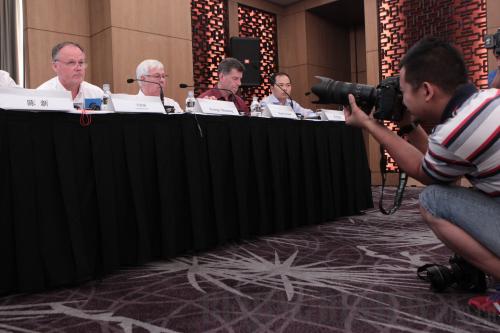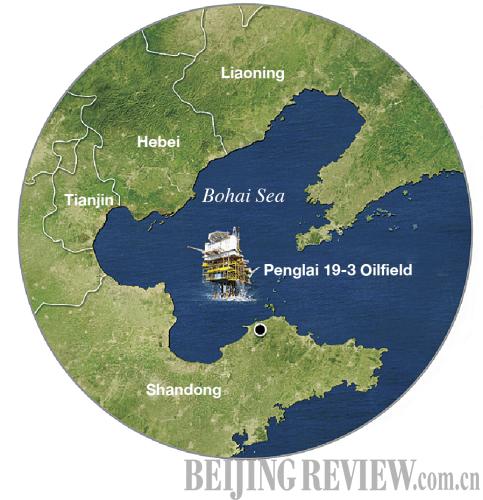|
 |
|
PUBLIC COMMITMENT: Senior executives of ConocoPhillips China attend a press conference in Beijing on August 24, pledging to complete the clean-up of oil spilled into the Bohai Bay before the August 31 deadline (XING GUANGLI) |
Civic efforts
Before the SOA announced its litigation plan, Jia Fangyi, a lawyer at Beijing's Great Wall Law Firm, filed a lawsuit against ConocoPhillips China and CNOOC. He sent files to maritime courts in Tianjin and Qingdao in Shandong and the Higher People's Court of Hainan Province in south China.
Jia demanded the companies set up a compensation fund of 10 billion yuan ($1.56 billion) to tackle pollution and recover ecological damages.
Some environmental NGOs, such as the Beijing-based Friend of Nature, have also planned to file lawsuits against ConocoPhillips China. But they were advised they did not have the legal standing to do so.
"China's Marine Environmental Protection Law stipulates departments overseeing the marine environment should claim compensation from liable parties on behalf of the country," said Xiao Jianhua, a law professor at China University of Political Science and Law in Beijing.
According to the law, he said, organizations or individuals other than the marine authorities do not have the legal standing to initiate class-action litigations over the Bohai Bay oil spill.
"Class-action litigations filed by individuals or civic groups are seldom accepted by courts," said Ma Yong, head of the Legal Affairs Department of the All-China Environment Federation, a Beijing-based NGO. Ma said most of the class-action lawsuits filed by his organization were rejected by courts on the grounds of improper legal standing.
But Jia said any citizen has the right to sue against damage to public interests, according to Article 3, 53 and 55 of the Civil Procedure Law of China.
Jia told the Beijing-based Procuratorial Daily, "The Bohai Sea is the common asset of China's 1.3 billion people. As one of them, of course I can file a lawsuit against actions that have done damage to it."
Dai Renwang, a professor of environmental law at China University of Political Science and Law, agrees with Jia. He said every citizen has a stake in state-owned ocean resources, so environmental NGOs and individuals can file class-action lawsuits over the Bohai Bay oil spill.
Wang Canfa, Executive Director of the Environment and Resources Law Society, also supports Jia. He said according to Article 6 of China's Environmental Protection Law, any organization or individual has the right to expose and sue those damaging the environment.
Timeline of the Bohai Bay Oil Spill
June 4
The North Sea Branch of the State Oceanic Administration (SOA) received a report from ConocoPhillips China describing a visible oil sheen from an unidentified source found near Platform B of the Penglai 19-3 Oilfield.
June 17
A SOA surveillance ship observed a spill at Platform C of the Penglai 19-3 Oilfield during drilling.
July 5
The SOA held a press conference on the oil contamination.
July 6
ConocoPhillips China issued a news release saying the source of the oil spill was quickly and effectively contained and the sheen clean-up was close to completion.
July 11
The SOA spotted oil seepage from Platform C of the Penglai 19-3 Oilfield.
July 13
The SOA ordered ConocoPhillips China to shut down production at Platform B and C of the Penglai 19-3 Oilfield.
July 14
ConocoPhillips China estimated the aggregate amount of spilled oil and oil-based mud to be approximately 1,500 barrels (240 cubic meters).
July 31
The SOA urged ConocoPhillips China to speed up clean-up efforts.
August 3
Frogmen discovered additional locations of oil-based mud on the seabed near Platform C of the Penglai 19-3 Oilfield.
August 12
ConocoPhillips China upped its estimate of the aggregate amount of spilled oil and oil-based mud to 2,500 barrels (400 cubic meters).
August 19
ConocoPhillips China released a statement apologizing for the oil contamination.
August 20
ConocoPhillips China admitted finding nine additional seepage points near Platform C of the Penglai 19-3 Oilfield.
August 24
ConocoPhillips China said 95 percent of the oil-based mud on the seabed of the Bohai Bay had been cleaned up and the removal of the remaining contaminated mud would be completed by the end of August.
(Source: Xinhua News Agency)

China's Oil-Rich Gulf
The Bohai Sea, with an area of nearly 80,000 square km, borders Liaoning, Hebei and Shandong provinces and Tianjin Municipality in north China. It has three bays, with the Laizhou Bay to the south, Liaodong Bay to the north and Bohai Bay to the west. At the end of 2009, there were 20 oilfields with 165 rigs in the Bohai Sea | 